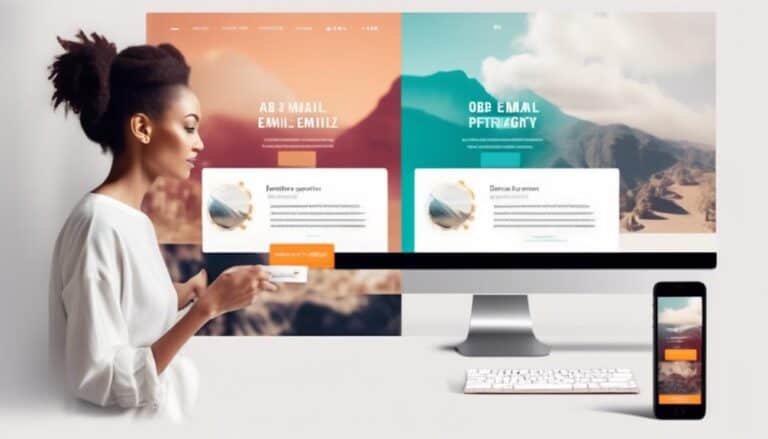Urgent Update: The Must-Know Email Segmentation Tactics of 2024
Imagine you're a captain navigating a vast sea of emails, trying to find the hidden treasure of engagement and conversion.
In this ever-evolving digital landscape, it's crucial to stay afloat with the latest email segmentation tactics.
The year 2024 brings a fresh wave of strategies that can help you navigate these treacherous waters and unlock the true potential of your email marketing campaigns.
From personalization trends to leveraging AI, advanced segmentation techniques to behavioral strategies, this urgent update will equip you with the must-know tactics that will set you apart from the competition.
But the question remains: Are you ready to discover the secrets that will transform your email marketing into a treasure trove of success?
Key Takeaways
- Email segmentation and personalization are crucial for maximizing the effectiveness of email marketing campaigns in 2024.
- Dynamic content personalization and behavioral segmentation are key trends that enhance engagement and conversion rates.
- Personalized emails improve the customer experience, resulting in higher open rates, click-through rates, and conversion rates.
- Advanced segmentation techniques, such as targeting specific criteria and creating detailed customer profiles, lead to higher engagement and conversions.
Importance of Email Segmentation

Email segmentation is a crucial strategy for maximizing the effectiveness of your email marketing campaigns. By segmenting your email list based on specific criteria, you can tailor your messages to better resonate with different groups of recipients. This approach not only increases the chances of engagement but also enhances the overall experience for your subscribers.
Segmentation allows you to send targeted emails that address the unique needs and preferences of different segments. By understanding your audience and their behaviors, you can create personalized content that speaks directly to their interests. This level of personalization leads to higher open rates, click-through rates, and ultimately, better conversion rates.
One of the key benefits of email segmentation is improved customer retention. By sending relevant and timely messages, you can nurture your relationships with subscribers and keep them engaged with your brand. Additionally, segmentation enables you to send automated emails based on specific triggers or events, such as abandoned cart reminders or birthday greetings. These automated campaigns save time and effort while delivering a personalized experience to your subscribers.
To implement email segmentation effectively, it's essential to follow segmentation best practices. Start by collecting relevant data about your subscribers, such as demographics, purchase history, or engagement patterns. Use this data to create distinct segments and develop targeted email campaigns for each group. Regularly analyze the results of your campaigns and make adjustments as necessary to optimize your segmentation strategy.
Personalization Trends in 2024
Are you looking to boost the effectiveness of your email marketing campaigns in 2024?
Two key personalization trends to consider are dynamic content personalization and behavioral segmentation.
With dynamic content personalization, you can tailor the content of your emails to each individual recipient based on their preferences and past interactions.
Behavioral segmentation allows you to categorize your subscribers into different groups based on their behaviors and interests, allowing for more targeted and relevant messaging.
Incorporating these trends into your email segmentation tactics can help you achieve higher engagement and conversion rates.
Dynamic Content Personalization
With the rise of personalization trends in 2024, dynamic content personalization has emerged as a powerful tactic to engage and convert email recipients. By tailoring the content of your emails based on individual preferences and behaviors, you can create a personalized experience that resonates with your audience and drives higher engagement and conversions.
Here are four key benefits of implementing dynamic content personalization in your email marketing strategies:
- Increased relevance: By delivering content that's highly relevant to each recipient's interests and needs, you can capture their attention and increase the chances of them taking the desired action.
- Improved customer experience: Personalized emails make recipients feel valued and understood, leading to a positive customer experience that fosters loyalty and repeat business.
- Higher open and click-through rates: When emails are personalized and targeted, recipients are more likely to open them and click on the included links, resulting in higher engagement rates.
- Enhanced conversion rates: By delivering personalized content that speaks directly to recipients' pain points and motivations, you can increase the likelihood of them converting into customers or taking the desired action.
Incorporating dynamic content personalization into your email marketing strategies can revolutionize your campaigns and drive better results. Stay ahead of the competition by embracing this innovative tactic and providing your audience with the personalized experiences they crave.
Behavioral Segmentation
As personalization trends continue to shape the email marketing landscape in 2024, leveraging behavioral segmentation has become a crucial strategy to drive engagement and conversions. By analyzing user engagement and purchase behavior, marketers can tailor their email campaigns to target specific actions and preferences. This data-driven approach allows for a more personalized and relevant email experience, increasing the likelihood of click-throughs, conversions, and customer loyalty. Take a look at the table below to see how behavioral segmentation can be implemented in email marketing:
| User Engagement | Purchase Behavior |
|---|---|
| Abandoned Cart | Repeat Purchases |
| Email Opens | High-Value Items |
| Click-Throughs | Cross-Selling |
| Inactive Users | Up-Selling |
| Website Visits | Discount Offers |
Advanced Segmentation Techniques

Are you looking for ways to take your email segmentation to the next level?
Advanced segmentation techniques can help you target your audience more effectively and deliver personalized content that resonates with each individual recipient.
By segmenting your email list based on specific criteria such as demographics, behavior, or purchase history, you can tailor your messages to meet the unique needs and preferences of your subscribers.
This level of customization can lead to higher engagement, increased conversions, and ultimately, a more successful email marketing strategy.
Targeted Audience Segmentation
To effectively segment your audience and implement advanced segmentation techniques, consider leveraging data-driven insights and employing targeted messaging based on specific customer attributes and behaviors. This approach allows you to personalize your email campaigns and deliver highly relevant content to different segments of your audience.
Here are four key strategies for targeted audience segmentation:
- Customer Profiling: Build detailed profiles of your customers by gathering data on their demographics, preferences, and purchase history. This information helps you understand their needs and interests, enabling you to tailor your messages accordingly.
- Demographic Segmentation: Divide your audience based on demographic factors such as age, gender, location, and income. This segmentation enables you to create personalized content that resonates with each group, increasing engagement and conversions.
- Behavioral Segmentation: Analyze customer behaviors such as browsing patterns, purchase frequency, and engagement with previous emails. Use this data to segment your audience and deliver emails that align with their specific actions and interests.
- Dynamic Segmentation: Continuously update your segments based on real-time data to ensure your messaging remains relevant. By dynamically segmenting your audience, you can respond to changes in customer behavior and preferences, maximizing the effectiveness of your email campaigns.
Implementing targeted audience segmentation allows you to deliver personalized, data-driven emails that resonate with your recipients. By leveraging customer profiling, demographic segmentation, behavioral segmentation, and dynamic segmentation, you can optimize your email marketing strategy and drive better results. Stay ahead of the competition by embracing these advanced segmentation techniques today.
Personalized Content Delivery
To optimize your email marketing strategy and drive better results, it's crucial to employ advanced segmentation techniques for personalized content delivery.
Customized recommendations and adaptive email campaigns are key to engaging your audience in a more targeted and effective way. By analyzing customer data and behavior, you can create tailored content that resonates with each individual subscriber.
Gone are the days of sending generic emails to your entire list. With advanced segmentation, you can deliver content that feels like it was specifically crafted for each person, increasing the chances of conversion and customer loyalty.
By leveraging dynamic content blocks and personalized subject lines, you can create a unique and relevant experience for every subscriber, resulting in higher open rates and click-through rates.
Don't miss out on the power of personalized content delivery – start implementing advanced segmentation techniques today.
Leveraging AI for Segmentation
Leverage the power of AI to enhance your email segmentation strategy and drive targeted engagement with your audience. With AI powered segmentation strategies, you can optimize your email campaigns and achieve better results. Here's how:
- Personalized Recommendations: AI algorithms analyze user behavior, preferences, and purchase history to deliver personalized product recommendations. By segmenting your audience based on their interests and previous interactions, you can create tailored email content that resonates with each individual, increasing the chances of conversions.
- Predictive Analytics: AI can analyze vast amounts of data to predict customer behavior and identify patterns. By segmenting your audience based on these predictive insights, you can send targeted emails at the right time, maximizing the chances of engagement and conversion.
- Dynamic Content Generation: AI can dynamically generate personalized content based on individual preferences and behavior. By segmenting your audience and utilizing AI-powered content generation, you can deliver highly relevant and compelling emails that capture the attention of your subscribers.
- Automated Segmentation: AI can automate the segmentation process by analyzing various data points such as demographics, purchase history, and engagement levels. This allows you to create precise segments and optimize your email campaigns without manual intervention, saving time and resources.
Behavioral Segmentation Strategies

Implementing behavioral segmentation strategies in your email campaigns can significantly improve engagement and conversion rates. By analyzing the customer journey and leveraging predictive analytics, you can tailor your email content to match the specific interests and behaviors of each individual recipient.
Behavioral segmentation allows you to go beyond basic demographic information and target your audience based on their actions and preferences. By monitoring how your subscribers interact with your emails, such as opens, clicks, and purchases, you can gain valuable insights into their interests and motivations. This data enables you to create personalized and relevant content that resonates with each recipient, increasing the likelihood of engagement and conversion.
Predictive analytics takes behavioral segmentation a step further by using machine learning algorithms to predict future actions based on past behavior. By understanding the patterns and trends in your subscribers' actions, you can anticipate their needs and send targeted emails at the right time. This proactive approach enhances the customer experience and maximizes the chances of conversion.
Incorporating behavioral segmentation and predictive analytics into your email campaigns allows you to deliver the right message to the right person at the right time. By leveraging data-driven insights, you can create a more personalized and engaging experience for your subscribers, driving higher engagement and conversion rates.
Stay ahead of the curve and take advantage of these innovative strategies to optimize your email marketing efforts.
The Role of Dynamic Content
By incorporating dynamic content into your email campaigns, you can further personalize your messaging based on the specific interests and behaviors of each individual recipient. This innovative approach offers several benefits:
- Increased Relevance:
Dynamic content allows you to tailor your emails to each recipient's preferences, ensuring that they receive content that resonates with them. By leveraging artificial intelligence (AI) algorithms, you can analyze and understand individual behavior patterns, enabling you to deliver highly relevant content.
- Improved Engagement:
When recipients receive personalized and relevant content, they're more likely to engage with your emails. Dynamic content personalization enables you to deliver targeted offers, recommendations, and personalized product suggestions, increasing the chances of conversion and customer satisfaction.
- Enhanced Customer Experience:
Personalized emails make your customers feel valued and understood. By utilizing dynamic content, you can create a seamless and personalized customer experience, building stronger relationships with your audience.
- Optimized Conversion Rates:
By delivering highly relevant and personalized content, you can significantly improve your email conversion rates. Dynamic content allows you to deliver the right message to the right person at the right time, increasing the likelihood of conversion.
Incorporating dynamic content into your email campaigns through the use of AI not only enhances personalization but also drives engagement, improves the customer experience, and boosts conversion rates. Stay ahead of the curve by leveraging the power of dynamic content in your email marketing strategy.
Metrics to Measure Segmentation Success

To effectively measure the success of your email segmentation strategy, it is crucial to track and analyze key metrics that provide insights into the performance and impact of your segmented campaigns. By measuring effectiveness and conducting segmentation analysis, you can optimize your campaigns and achieve better results.
One way to measure the effectiveness of your email segmentation is through open rates. This metric indicates how many recipients opened your email, giving you an idea of the level of interest and engagement. Another important metric is click-through rates (CTR), which measures the number of recipients who clicked on a link within your email. This metric helps you assess the relevance and effectiveness of your content. Lastly, conversion rates are crucial to measure the ultimate success of your segmented campaigns. This metric tracks the number of recipients who completed a desired action, such as making a purchase or filling out a form.
To help you visualize the impact of these metrics, here is a table summarizing the key metrics for measuring segmentation success:
| Metric | Definition | Importance |
|---|---|---|
| Open Rates | Percentage of recipients who opened | Indicates interest and engagement |
| Click-through Rates (CTR) | Percentage of recipients who clicked on a link | Measures content relevance and effectiveness |
| Conversion Rates | Percentage of recipients who completed a desired action | Tracks ultimate campaign success |
Frequently Asked Questions
How Do I Create an Email Segmentation Strategy for My Business?
To create a successful email segmentation strategy for your business, start by understanding your audience and their preferences. Use data-driven insights to personalize emails and measure the success of your segmentation tactics. Stay innovative and stay ahead of the competition.
What Are the Common Challenges Faced When Implementing Email Segmentation?
When implementing email segmentation, you may face challenges with data analysis and automation. It's important to have a clear strategy in place to overcome these obstacles and ensure successful segmentation for your business.
How Can I Effectively Utilize Machine Learning Algorithms for Email Segmentation?
To effectively utilize machine learning algorithms for email segmentation, apply predictive analytics to personalize your emails. These tactics leverage data-driven insights, ensuring innovation in your email marketing strategy for maximum impact and engagement.
What Are the Best Practices for Segmenting and Targeting Specific Customer Demographics?
Segmenting and targeting specific customer demographics is essential for personalized email marketing campaigns. By leveraging data analytics, you can enhance your email segmentation strategies, resulting in increased customer engagement and improved campaign performance.
How Can I Integrate Email Segmentation With Other Marketing Channels for a Cohesive Customer Experience?
To integrate email segmentation with social media marketing, leverage personalized retargeting campaigns. By targeting specific customer demographics, you can create a cohesive customer experience that drives engagement and boosts conversions. Stay ahead with innovative tactics.
Conclusion
In conclusion, email segmentation is an essential strategy in 2024 for effective personalization and engaging customers. By leveraging advanced segmentation techniques and AI, businesses can tailor their content to target specific behaviors and preferences.
The use of dynamic content and measuring segmentation success through metrics allows for continuous improvement and optimization. Adopting these tactics will ensure higher open rates, click-through rates, and overall success in email marketing campaigns.
Stay ahead of the competition by implementing these must-know segmentation tactics.








